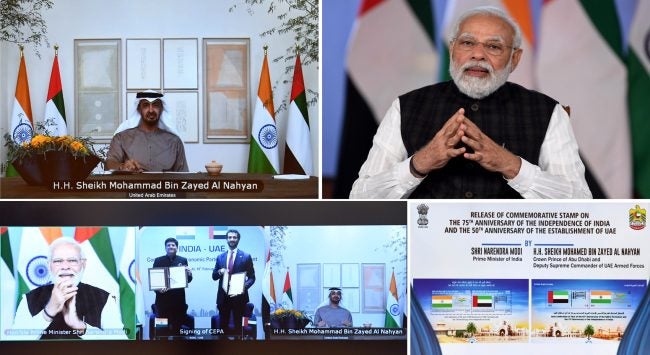India-United Arab Emirates CEPA: New Beginning in India’s Trade Engagement
Amitendu Palit
23 February 2022Summary
India’s trade agreement with the United Arab Emirates marks a new period of engagement in its external trade policy that could be increasingly conditioned by geopolitics and geo-economics.
India and the United Arab Emirates (UAE) signed a comprehensive economic partnership agreement (CEPA) on 18 February 2022. The CEPA is expected to augment the current bilateral trade of US$60 billion to US$100 billion (S$80.73 billion to S$134.55 billion) in the next five years, including an increase in bilateral trade in services by US$15 billion (US$20.18 billion). The deal was concluded in a remarkably short period of time with the negotiations having begun only in September 2021.
The agreement with the UAE is the first trade agreement signed by India in several years. India’s external trade policy in the last seven to eight years has been marked by scepticism towards free trade agreements (FTAs). It had put on hold several ongoing trade talks, including those with the European Union (EU), Australia and Canada. The strongest example of scepticism was its withdrawal from the Regional Comprehensive Economic Partnership in November 2019.
Since early 2021, India has picked up trade negotiations with several countries. These include the United Kingdom (UK) and the UAE, Australia, Canada and the EU. India is also exploring the possibility of trade deals with Israel and the Gulf Cooperation Council.
Given India’s reticence in engaging in FTAs, there were doubts over whether the deals it was engaged in would eventually fructify. The signing of the agreement with the UAE puts to rest such doubts. The deal will instil confidence in India as well as the countries with which it is negotiating on the successful conclusion of ongoing trade talks.
India’s trade agreement with the UAE formalises a trade and business relationship that is already strong and robust. The UAE is India’s third-largest trade partner and the second-largest destination for India’s exports after the United States (US). With large scale tariff reductions expected in the CEPA, several of India’s major exports are eyeing attractive prospects. These include gems and jewellery, apparel and plastics. Being labour-intensive in nature, the good prospects for these exports mean bright prospects for domestic employment.
As India’s Commerce Minister Piyush Goyal pointed out, the CEPA can generate several jobs, not just from the increase in labour-intensive exports but also from the movement of students and exchanges between universities and other educational institutions. Efforts to mutually recognise educational qualifications will be a significant step in increasing job prospects for technically trained Indians in the UAE. The Emirates have already become a major destination for Indian students. Student movements are expected to accelerate with the FTA expanding job opportunities.
The CEPA with the UAE should also be looked at in the larger strategic context of the countries with which India is currently negotiating trade deals. India’s strategic relations with these countries – the UK, Australia, Canada, the EU and Israel – have elevated rapidly in recent years. They are India’s core partners in the new geo-economic and geopolitical partnerships that it is invested in. These are notably the ‘Eastern’ Quad comprising the US, India, Japan and Australia; and the ‘Western’ Quad, consisting of the US, India, the UAE and Israel.
The fact that India is looking to ink FTAs with all members of the two Quads – except the US with whom it is nonetheless engaged in bilateral trade-enabling talks – shows its inclination to formalise rules-based trade and business relations with countries with which it is committed to long-term deep strategic relations. The CEPA with the UAE marks the beginning of the process.
India’s efforts to craft FTAs with geopolitically important partners is also driven by the geo-economics accompanying these political alignments. All of India’s FTA engagements are with countries with which it is working on safeguarding critical supply chains. These are also countries that are major sources of inward investments into India.
The UAE, for example, invested more than US$4 billion (S$5.48 billion) in India in FY2020 through its sovereign wealth funds. It also has a variety of long-term investments in infrastructure and logistics industries in India.
Further, India’s new ‘FTA engagement countries’, such as the UAE, the UK, Canada and Australia, have large concentrations of the new-generation Indian diaspora. Apart from enabling close people-to-people interactions, the large presence of the Indian diaspora is helping to fashion start-ups and new enterprises in these locations.
The signing of the CEPA with the UAE clearly marks the onset of a new period of engagement for India in its external trade policy, driven by the strategic choice of partners conditioned by geopolitics and geo-economics.
. . . . .
Dr Amitendu Palit is a Senior Research Fellow and Research Lead (Trade and Economic Policy) at the Institute of South Asian Studies (ISAS), an autonomous research institute at the National University of Singapore (NUS). He can be contacted at isasap@nus.edu.sg. The author bears full responsibility for the facts cited and opinions expressed in this paper.
Photo Credit: Photo Gallery of the Prime Minister’s Office
-
 More From :
More From :
-
 Tags :
Tags :
-
 Download PDF
Download PDF



